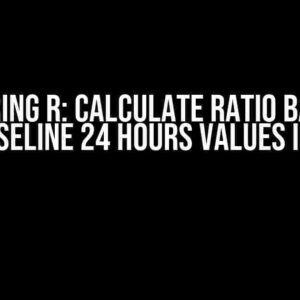Are you tired of dealing with cluttered and confusing survival plots in R? Do you struggle to customize the appearance of your strata indicators in ggsurvplot? Fear not, dear reader! In this comprehensive guide, we’ll take you by the hand and walk you through the process of adjusting the thickness of strata indicators in ggsurvplot. By the end of this article, you’ll be a master of survival plot customization, and your visualizations will shine like a beacon of clarity in a sea of data.
What is ggsurvplot?
Before we dive into the tutorial, let’s take a brief moment to introduce ggsurvplot. ggsurvplot is a popular R package that provides a convenient interface for creating survival plots using the grammar of graphics. It’s an extension of the ggplot2 package, and it’s specifically designed to work with survival data. ggsurvplot allows you to create stunning survival plots with ease, including Kaplan-Meier curves, cumulative incidence curves, and more.
So, why is it important to adjust the thickness of strata indicators in ggsurvplot? The answer is simple: clarity and readability. When working with survival data, it’s essential to visualize the different strata (or groups) separately to identify trends and patterns. However, if the strata indicators are too thin or too thick, they can become distracting or overwhelming, making it difficult to interpret the plot.
By adjusting the thickness of strata indicators, you can create a more balanced and harmonious plot that effectively communicates the insights in your data. A well-crafted survival plot can help you:
- Identify differences in survival rates between groups
- Visualize the impact of covariates on survival outcomes
- Compare treatment effects across different groups
- Spot trends and patterns in survival data
Adjusting the Thickness of Strata Indicators: A Step-by-Step Guide
Now that we’ve covered the importance of adjusting strata indicators, let’s get started with the tutorial! We’ll use the built-in lung dataset in R to create a sample survival plot.
library(survminer)
library(ggplot2)
data(lung)
ggsurvplot(survfit(Surv(time, status) ~ ph.ecog, data = lung),
main = "Survival Curve by ECOG Performance Status",
xlab = "Time in Days",
ylab = "Survival Probability",
Risk.Table = "abs_pct",
palette = "jco",
ggtheme = theme_classic())
This code creates a basic survival plot with two strata indicators: ECOG Performance Status 0 and ECOG Performance Status 1-2-3. The resulting plot is shown below:
 |
As you can see, the strata indicators are quite thin, making it difficult to distinguish between the two groups. Let’s adjust the thickness of the strata indicators to improve the plot’s readability.
Method 1: Using the strata.size Argument
The easiest way to adjust the thickness of strata indicators is by using the strata.size argument within the ggsurvplot() function. This argument takes a numerical value that represents the size of the strata indicators in pixels.
ggsurvplot(survfit(Surv(time, status) ~ ph.ecog, data = lung),
main = "Survival Curve by ECOG Performance Status",
xlab = "Time in Days",
ylab = "Survival Probability",
Risk.Table = "abs_pct",
palette = "jco",
strata.size = 2,
ggtheme = theme_classic())
By setting strata.size = 2, we’ve increased the thickness of the strata indicators to 2 pixels. The resulting plot is shown below:
 |
As you can see, the strata indicators are now more prominent and easier to distinguish.
Method 2: Customizing the geom_strata() Layer
The second method involves customizing the geom_strata() layer within the ggsurvplot() function. This method provides more flexibility and control over the appearance of the strata indicators.
ggsurvplot(survfit(Surv(time, status) ~ ph.ecog, data = lung),
main = "Survival Curve by ECOG Performance Status",
xlab = "Time in Days",
ylab = "Survival Probability",
Risk.Table = "abs_pct",
palette = "jco",
ggtheme = theme_classic()) +
geom_strata(aes(y = strata, color = strata),
size = 3,
position = position_dodge(width = .1))
In this example, we’ve added a custom geom_strata() layer to the plot. We’ve set the size argument to 3, which increases the thickness of the strata indicators. We’ve also used the position_dodge() function to adjust the position of the strata indicators, making them more visually appealing.
 |
The resulting plot shows more prominent and well-spaced strata indicators, making it easier to interpret the survival data.
Conclusion
In this tutorial, we’ve learned how to adjust the thickness of strata indicators in ggsurvplot using two different methods: the strata.size argument and customizing the geom_strata() layer. By applying these techniques, you can create more effective and readable survival plots that effectively communicate the insights in your data.
Remember, the key to creating stunning survival plots is to strike a balance between clarity and aesthetics. Don’t be afraid to experiment with different customization options in ggsurvplot to find the perfect combination that works for your data.
Further Reading
For more information on customizing survival plots with ggsurvplot, check out the following resources:
Happy plotting, and don’t forget to share your stunning survival plots with the world!
Frequently Asked Questions
Get ready to uncover the secrets of gg survplot and master the art of adjusting the thickness of strata indicators!
How do I adjust the thickness of strata indicators in gg survplot?
You can adjust the thickness of strata indicators in gg survplot by adding the `size` argument within the `geom_line()` function. For example, `gg survplot(…) + geom_line(size = 0.5)` will make the lines thinner, while `gg survplot(…) + geom_line(size = 2)` will make them thicker.
Can I customize the thickness of individual strata indicators?
Yes, you can customize the thickness of individual strata indicators by using the `aes()` function within `geom_line()` to map the `size` aesthetic to a specific variable. For example, `gg survplot(…) + geom_line(aes(size = strata))` will make the thickness of each strata indicator proportional to the value of the `strata` variable.
How do I make all strata indicators the same thickness?
To make all strata indicators the same thickness, you can simply remove the `aes()` function within `geom_line()` or set the `size` argument to a fixed value. For example, `gg survplot(…) + geom_line(size = 1)` will make all strata indicators the same thickness.
Can I use different line types for different strata indicators?
Yes, you can use different line types for different strata indicators by using the `aes()` function within `geom_line()` to map the `linetype` aesthetic to a specific variable. For example, `gg survplot(…) + geom_line(aes(linetype = strata))` will make each strata indicator have a unique line type.
How do I adjust the legend key for the strata indicators?
You can adjust the legend key for the strata indicators by customizing the `scale_size()` or `scale_linetype()` function. For example, `gg survplot(…) + scale_size(name = “Strata”, breaks = c(0.5, 1, 2))` will customize the legend key for the line thickness.







